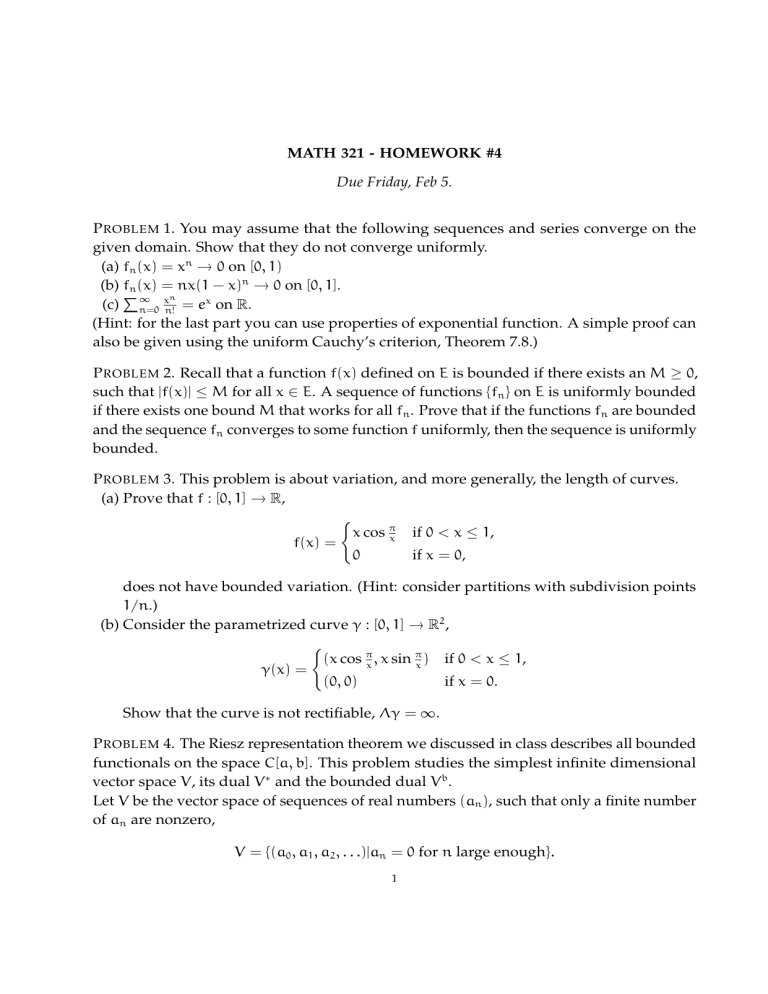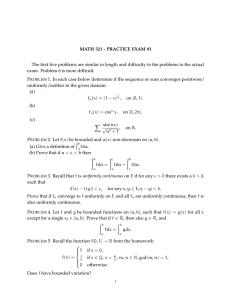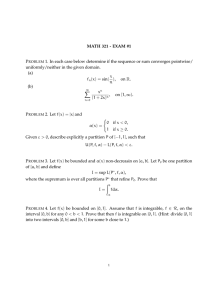MATH 321 - HOMEWORK #4 Due Friday, Feb 5. P

MATH 321 - HOMEWORK #4
Due Friday, Feb 5.
P ROBLEM 1. You may assume that the following sequences and series converge on the given domain. Show that they do not converge uniformly.
(a)
(b)
(c) f f n n
(
( x x
∞
) =
) = n = 0 x n n !
x n nx
=
(
→
0 on [ 0, 1 )
→
0 on [ 0, 1 ] .
e
1 x
− on x )
R n
.
(Hint: for the last part you can use properties of exponential function. A simple proof can also be given using the uniform Cauchy’s criterion, Theorem 7.8.)
P ROBLEM 2. Recall that a function f ( x ) defined on E is bounded if there exists an M ≥ 0 , such that | f ( x )
| ≤ M for all x ∈ E . A sequence of functions { f n
} on E is uniformly bounded if there exists one bound M that works for all f n
. Prove that if the functions f n are bounded and the sequence f n converges to some function f uniformly, then the sequence is uniformly bounded.
P ROBLEM 3. This problem is about variation, and more generally, the length of curves.
(a) Prove that f : [ 0, 1 ]
→
R
, f ( x ) = x cos π x
0 if 0 < x ≤ 1 , if x = 0 , does not have bounded variation. (Hint: consider partitions with subdivision points
1/n .)
(b) Consider the parametrized curve γ : [ 0, 1 ]
→
R
2 ,
γ ( x ) =
( x cos π x
, x sin π x
) if 0 < x ≤ 1 ,
( 0, 0 ) if x = 0 .
Show that the curve is not rectifiable, Λγ =
∞ .
P ROBLEM 4. The Riesz representation theorem we discussed in class describes all bounded functionals on the space C [ a, b ] . This problem studies the simplest infinite dimensional vector space V , its dual V
∗ and the bounded dual V b .
Let V be the vector space of sequences of real numbers ( a n
) , such that only a finite number of a n are nonzero,
V =
{
( a
0
, a
1
, a
2
, . . .
)
| a n
= 0 for n large enough }
.
1
The vector space V has a countable basis e
0
= ( 1, 0, 0, . . .
) , e
1
= ( 0, 1, 0, 0, . . .
) , e
2
= ( 0, 0, 1, 0, . . .
) , . . . .
To define a linear function L : V
→
R
, we need to specify the values of L on the basis:
L ( e
0
) = b
0
, L ( e
1
) = b
1
, L ( e
2
) = b
2
, . . . .
This way we can identify the dual space V
∗ with the space of all sequences ( b n
) , with no restriction on vanishing. A linear function ( b n
) acts on V by dot product.
Let V have the norm
Recall that a linear function L ∈ V
∗ v = ( a n
) ∈ V , k ( a n
) k = max n
| a n
|
.
is bounded if there exists an M ≥ 0 , such that for every
|
L ( v )
| ≤ M k v k .
The smallest such bound is defined to be the norm of L : k L k = sup v = 0
|
L ( v )
| k v k
= sup k v k = 1
|
L ( v )
|
.
(a) Show that the linear function
( 1, 1, . . .
) ∈ V
∗ is not bounded.
(b) For any b = ( b n
) ∈ V
∗
, show that k b k =
X
| b n
|
.
n
In particular, the subspace of bounded linear functions V b
( b n
) such that n
| b n
|
<
∞
.
⊂ V
∗ is the set of sequences
(c) Show that every element of V defines (by dot product) a bounded linear function
V b →
R
, giving a linear map:
V
→
V b b
, but this map is not surjective. For example, the sequence ( 1, 1, . . .
) defines and element of V b b that does not come from V .








